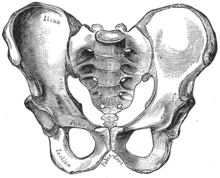Sacroiliac joint arthrosis

| Classification according to ICD-10 | |
|---|---|
| M19.9 | Other osteoarthritis, unspecified |
| ICD-10 online (WHO version 2019) | |
The sacroiliac joint osteoarthritis is a wear and tear disease ( arthrosis ) of the sacroiliac joint (sacrum and sacrum).
The bony pelvis forms the foundation on which the rest of the spine is built. The forces generated by the load change when walking are introduced into the pelvis via the hip joints. There are small movements of the pelvis when the load changes. These movements take place in the symphysis and the sacro-iliac joints.
Symptoms
The pain resulting from a Iliosakralgelenksarthrose are easily with a stimulation of the sciatic to be confused -Nervs, the pain can be in a leg or in both irradiated, can lead to disorders of the skin sensation, painful each step.
therapy
If osteoarthritis has developed, treatment options are limited. So-called buffer heels or shoes with the softest possible rubber heels can be preventative. In principle, the entire range of conservative orthopedics can be used to treat pain, tailored to the individual case: physiotherapy with massages and physiotherapy , osteopathy , electrical stimulation , but also local infiltration, acupuncture and possibly systemic drugs such as non-steroidal anti-inflammatory drugs .
Furthermore, an operative treatment option is available in which the joint gap is spread by means of a helical implant and subsequently the formation of a bony connection and stiffening is sought (distraction interference arthrodesis).
Individual evidence
- ↑ Alphabetical index for the ICD-10-WHO version 2019, volume 3. German Institute for Medical Documentation and Information (DIMDI), Cologne, 2019, p. 80
- ^ Website of a co-inventor of the therapy, Dr. John Stark - http://www.backpainclinic.com/backs/Sacroiliac_Joint.htm
